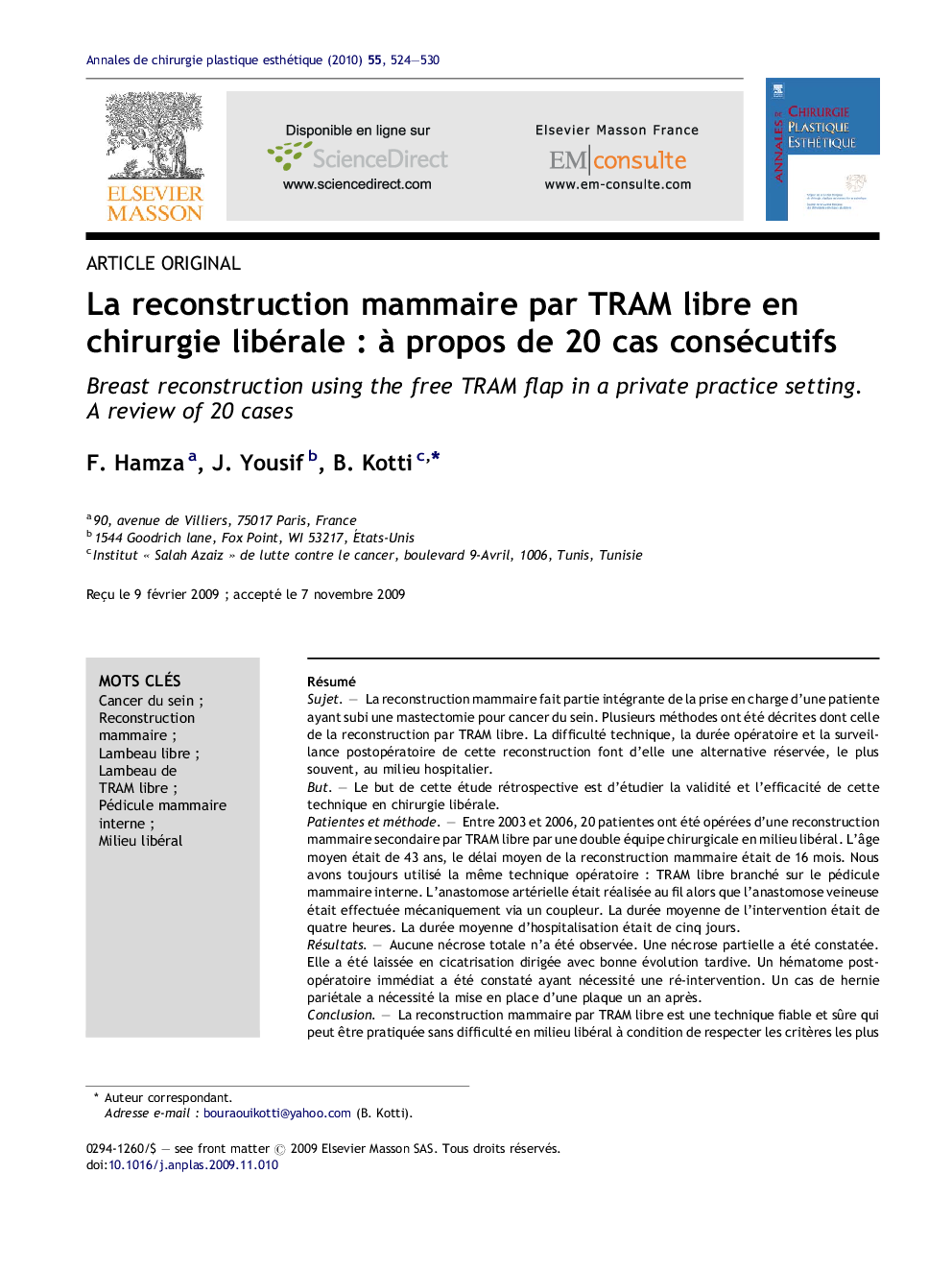| Article ID | Journal | Published Year | Pages | File Type |
|---|---|---|---|---|
| 3184933 | Annales de Chirurgie Plastique Esthétique | 2010 | 7 Pages |
RésuméSujetLa reconstruction mammaire fait partie intégrante de la prise en charge d’une patiente ayant subi une mastectomie pour cancer du sein. Plusieurs méthodes ont été décrites dont celle de la reconstruction par TRAM libre. La difficulté technique, la durée opératoire et la surveillance postopératoire de cette reconstruction font d’elle une alternative réservée, le plus souvent, au milieu hospitalier.ButLe but de cette étude rétrospective est d’étudier la validité et l’efficacité de cette technique en chirurgie libérale.Patientes et méthodeEntre 2003 et 2006, 20 patientes ont été opérées d’une reconstruction mammaire secondaire par TRAM libre par une double équipe chirurgicale en milieu libéral. L’âge moyen était de 43 ans, le délai moyen de la reconstruction mammaire était de 16 mois. Nous avons toujours utilisé la même technique opératoire : TRAM libre branché sur le pédicule mammaire interne. L’anastomose artérielle était réalisée au fil alors que l’anastomose veineuse était effectuée mécaniquement via un coupleur. La durée moyenne de l’intervention était de quatre heures. La durée moyenne d’hospitalisation était de cinq jours.RésultatsAucune nécrose totale n’a été observée. Une nécrose partielle a été constatée. Elle a été laissée en cicatrisation dirigée avec bonne évolution tardive. Un hématome postopératoire immédiat a été constaté ayant nécessité une ré-intervention. Un cas de hernie pariétale a nécessité la mise en place d’une plaque un an après.ConclusionLa reconstruction mammaire par TRAM libre est une technique fiable et sûre qui peut être pratiquée sans difficulté en milieu libéral à condition de respecter les critères les plus stricts de la microchirurgie et une bonne stratégie de gestion et d’organisation de l’équipe chirurgicale.
SummaryBackgroundThe breast reconstruction is an integral part of the treatment for breast cancer after mastectomy. A lot of methods were described like the free TRAM flap reconstruction. The technical difficulty, the length of the procedure and the post-operative monitoring of this reconstruction make it as an alternative used generally in a hospital setting.PurposeThe goal of this retrospective study is to document the validity of this technique in the private practice setting.Patients and methodBetween 2003 and 2006, 20 patients were operated on for a breast reconstruction using a free TRAM flap by a double “melting-pot” surgical team in a private clinic in Tunisia. The average age was 43 years and the average delay for the breast reconstruction was 16 months after mastectomy. We have always used the same surgical technique: a free TRAM flap plugged on the internal mammary vessels. The arterial anastomosis was stitched by a thread and the venous anastomosis was done by using a microvascular anastomotic coupler. The average operating time was 4 hours. The average stay in the clinic was 5 days.ResultsThere was no total flap loss. We observed one partial necrosis that healed in 5 weeks with dressings, one hematoma that required a surgical evacuation at the second day and one case of abdominal wall weakness treated by a mesh repair at one year.ConclusionThe breast reconstruction using a free TRAM flap is a reliable and safe technique that can be used without any difficulties in a private practice setting if it is made by a surgical team familiar with microsurgery and respecting its criteria with also a good management and strategy for aftercare.
